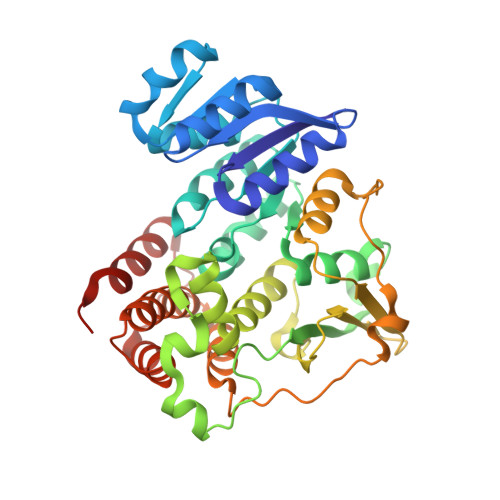Potent, specific MEPicides for treatment of zoonotic staphylococci.
Edwards, R.L., Heueck, I., Lee, S.G., Shah, I.T., Miller, J.J., Jezewski, A.J., Mikati, M.O., Wang, X., Brothers, R.C., Heidel, K.M., Osbourn, D.M., Burnham, C.D., Alvarez, S., Fritz, S.A., Dowd, C.S., Jez, J.M., Odom John, A.R.(2020) PLoS Pathog 16: e1007806-e1007806
- PubMed: 32497104
- DOI: https://doi.org/10.1371/journal.ppat.1007806
- Primary Citation of Related Structures:
6MH4, 6MH5 - PubMed Abstract:
Coagulase-positive staphylococci, which frequently colonize the mucosal surfaces of animals, also cause a spectrum of opportunistic infections including skin and soft tissue infections, urinary tract infections, pneumonia, and bacteremia. However, recent advances in bacterial identification have revealed that these common veterinary pathogens are in fact zoonoses that cause serious infections in human patients. The global spread of multidrug-resistant zoonotic staphylococci, in particular the emergence of methicillin-resistant organisms, is now a serious threat to both animal and human welfare. Accordingly, new therapeutic targets that can be exploited to combat staphylococcal infections are urgently needed. Enzymes of the methylerythritol phosphate pathway (MEP) of isoprenoid biosynthesis represent potential targets for treating zoonotic staphylococci. Here we demonstrate that fosmidomycin (FSM) inhibits the first step of the isoprenoid biosynthetic pathway catalyzed by deoxyxylulose phosphate reductoisomerase (DXR) in staphylococci. In addition, we have both enzymatically and structurally determined the mechanism by which FSM elicits its effect. Using a forward genetic screen, the glycerol-3-phosphate transporter GlpT that facilitates FSM uptake was identified in two zoonotic staphylococci, Staphylococcus schleiferi and Staphylococcus pseudintermedius. A series of lipophilic ester prodrugs (termed MEPicides) structurally related to FSM were synthesized, and data indicate that the presence of the prodrug moiety not only substantially increased potency of the inhibitors against staphylococci but also bypassed the need for GlpT-mediated cellular transport. Collectively, our data indicate that the prodrug MEPicides selectively and robustly inhibit DXR in zoonotic staphylococci, and further, that DXR represents a promising, druggable target for future development.
Organizational Affiliation:
Department of Pediatrics, Washington University School of Medicine, St. Louis, Missouri, United States of America.















